| Please access the following URL if you want to secure using SSL. All pages in the site will be secure pages. |
https://secure02.blue.shared-server.net/www.fish-food.co.jp/message english 4.2021.html |
Welcome to FISH FOOD TIMES
Apr. 2021 issue No.208

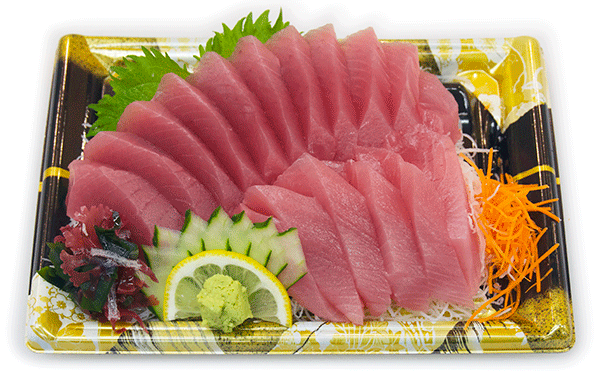
Young albacore hiratsukuri sashimi
Young albacore do not have long the hair at the temples
The standard Japanese name is binnaga, which is called various aliases in various places, but for the author, it is best to express it as bincyo.
Albacore is classified in the genus Scombridae, and according to the 2017 statistics of FAO (Food and Agriculture Organization of the United Nations), about 230,000 tons of albacore are caught annually in the world. The total catch of natural tuna in 2017 was about 2.28 million tons, albacore accounted for about 10% of the catch of tuna, and the largest catch was yellowfin tuna, which was about 1.48 million tons, and the second bigeye tuna is about 470,000 tons, and albacore is the third. However, albacore is on the ICUN (International Union for Conservation of Nature) Red List and is endangered, especially in the waters of the Atlantic Ocean. By the way, the catch of Pacific bluefin tuna in 2017 was about 39,000 tons, Atlantic bluefin tuna was about 35,000 tons, and Southern bluefin tuna was about 21,000 tons. Compared to these tuna species, albacore resources are still available, especially albacore resources in the South Pacific Ocean are at a high level, and it seems that the North Pacific Ocean, where Japan is located, is not in a state of concern about depletion.
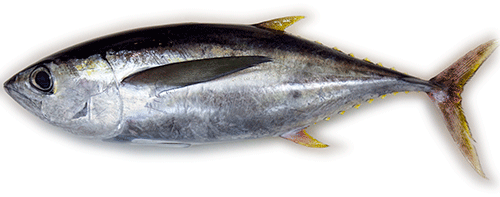
In the Nansei Islands, albacore is often called shibi, but the name shibi may refer to albacore or yellowfin tuna depending on the region. Generally, the name shibi is a general term for young and growing tuna, which seems to be convenient but not always convenient. In other words, when it is expressed as shibi, it is a name with ambiguity that makes you want to ask "Which shibi?" Therefore, to avoid such ambiguity, the expression Bincho is not confused with the yellowfin tuna shibi.
Albacore should characterize its length by looking at it as the hair at the temples, but growing young albacore is not as long as a grown-up adult with a pectoral fin extending behind the second dorsal fin.
n fact, the longtail tuna in the image below also uses the name bincyo as a local name in Nagasaki Prefecture.

It is true that the longtail tuna has a long pectoral fin as long as the young albacore, but on the other hand, the spots on the surface of the fish are similar to the bluefin tuna in the image below. The difference between longtail tuna and bluefin tuna is not only that the pectoral fin is long, but also that the morphology from anal fin to the tail fin is slimmer and longer than that of bluefin tuna.
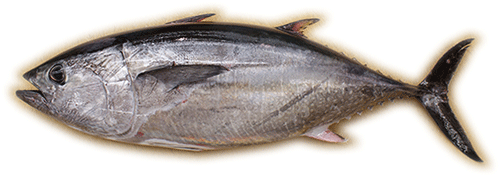
The longtail tuna is covered in the August 2016 issue No.152, so please refer to that. In this month's issue, I would like to write about albacore, especially the young albacore fish, whose catch increases from April in the height of spring to May in early summer.
Isn't it tuna?
Bluefin tuna, bigeye tuna, yellowfin tuna, etc. all express tuna, which means the type of tuna, but only albacore does not come with tuna. Although it is sometimes expressed as long fin tuna in English alias, it is just an alias. Why is this?
Even in Japan, albacore is treated more like bonito than a type of tuna, and statistical figures are often treated together with bonito. The main reason for this is that the bonito and albacore fishing methods are mainly single-line fishing, and the other relatively large tuna fishing methods are longline fishing. It is thought that the small tuna albacore has a history of being treated in the same way as bonito at the fishing stage.
Certainly, I have seen many times at the fishing port of the Nansei Islands from April to May that bonito and albacore are landed and sorted from fishing boats at the same time. Perhaps albacores, similar in size to bonito, behave similarly in the ocean, so they may be caught at the same time.
In other words, albacore is a fish classified in the genus Tuna, but it seems that it is treated like bonito instead of tuna not only in Japan but all over the world.
Even so, does albacore only have tuna in its English name? Although I searched variously, I found that the letters albacore were used for British combat airplanes and US submarines during World War II, but I could not find any other speculative material, so it is unknown. If anyone knows, please let me know.
From around April of this month, 2 to 3 kg of young albacore fish will be caught and landed in Japan by single fishing of bonito and albacore. Albacore is no exception to tuna, and it seems that it is common sense that the season is from autumn to winter when it gets fatty. However, the season starts around April, not in terms of the time when this fat is added, but in the sense of the time when a lot of fresh food is caught.
The 2-3 kg albacore caught around April and May is reasonably sized, very easy to use, and often reasonably priced, making it easy to handle. The bonito at this time was similar to albacore and had no fat on it, but in the case of bonito, the poem says "Blue leaves became more prominent in the field, and a singing cry of little cuckoo was heard in the mountains, and the first bonito came in the nearby sea.", And although bonito is very important, albacore is not particularly noticed and is pitiful.
After all, bonito is a very large existence with about 2.8 million tons caught worldwide in 2017 and about 200,000 tons in Japan alone. Compared to this, albacore landed about 20,000 tons nationwide in 2017, so its presence is 10 times wider.

And since about 80% of the 20,000 tons are caught from April to August every year, it can be said that the season of albacore is the last four months in the sense that it is a time to catch a lot.
Let's make it orthodox without deception by cheap tricks ...
By the way, how can we make albacore in season as of April deliciously eaten? There is no fat like cultured bluefin tuna, which is currently gaining popularity, and albacore is the opposite. Albacore has the lightest red color among tuna, and has a color that can be expressed as reddish whitish. There is a product called "Bintro" that takes this in the wrong direction and deceives by cheap tricks for customers. The author can only evaluate such a thing as "Toro ?, don't lie ...". Instead of selling iron with gold plating, iron should be sold with a simple iron-like texture.
For example, harakawa should not be cut and thrown away as an unnecessary part in the cooking stage, but the following work process to secure harakawa should be done properly. Originally it is a part of Toro, but in the case of albacore, we do not sell it like that, and even if we can not appeal the fat, we would like you to offer it as a rare part at a low price to our customers.
| Work process until commercialization of albacore harakawa | |
|---|---|
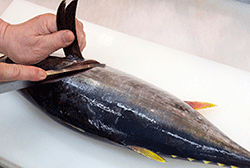 |
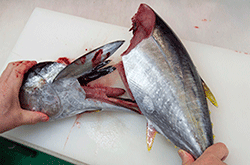 |
| 1,Cut next to the pectoral fin and cut to the spine. | 6,nstead of using a kitchen knife, hold the head and body with both hands and separate them. |
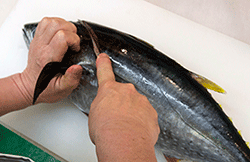 |
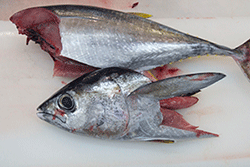 |
| 2,Cut a knife next to the pectoral fin on the upper body, but leave the head unseparated. | 7,The state where the head and body are separated. The internal organs remain on the head side, not on the body part. |
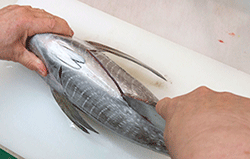 |
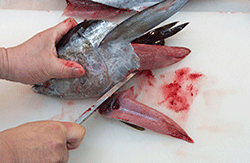 |
| 3,Make a shallow cut on only one side from the cut end of the pectoral fin on the upper body side to the anus. | 8,Separate harakawa from the head. |
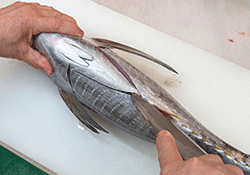 |
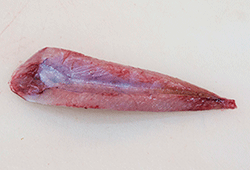 |
| 4,Also on the lower body side, make a shallow cut from the notch of the pectoral fin to the anus. | 9,Separated harakawa |
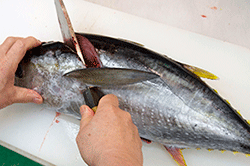 |
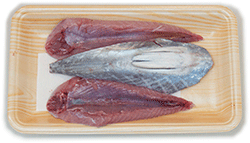 |
| 5,The part where the head and body are connected is separated, but the internal organs are not separated. | Albacore harakawa products |
Next, the fillet work process is described separately for the three pieces disassembling work process and the fillet work process.
| Albacore three pieces disassembling work process | |
|---|---|
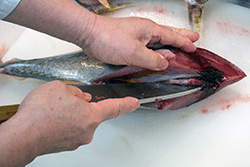 |
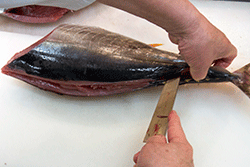 |
| 1,Make a cut in the large film of the lump of the blood attached to the backbone in the abdominal cavity. | 8,Cut the Yanagi blade knife between the backbone and the fish meat, and cut it toward the head. |
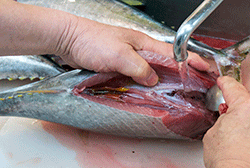 |
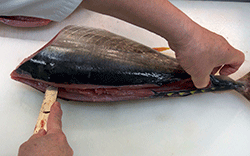 |
| 2,While running tap water, wash off the blood with a tool such as a spoon. | 9,Cut open between the backbone and fish meat to the end on the head side and separate. |
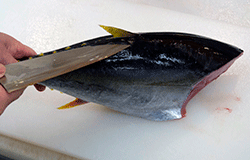 |
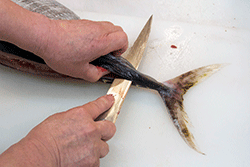 |
| 3,Make a cut in the dorsal fin on the lower body side using the method of a sakate knife, and cut to the head side. | 10,Cut off the connected part near the caudal fin. |
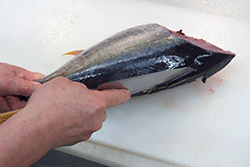 |
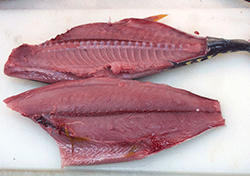 |
| 4,Make a cut in the dorsal fin on the upper body side using the method of a reverse-handed knife, and cut to the head side. | 11,harakawa has been removed and is in a state of two pieces disassembling |
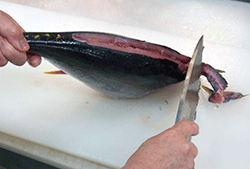 |
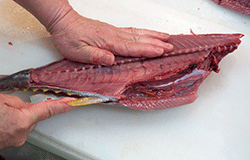 |
| 5,Make a cut in the dorsal fin from the position closest to the caudal fin and cut it toward the head. | 12,Make a notch under the anal fin with the central bone facing up and cut open to the back bone. |
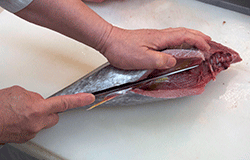 |
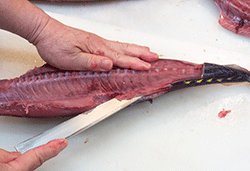 |
| 6,Switch to a yanagiba knife, make a notch at the anal fin on the lower body side, and cut open to the position of the backbone. | 13,With the centralbone on top, make a cut under the centralbone at the time of dorsal fin and cut open to the position of the dorsal fin. |
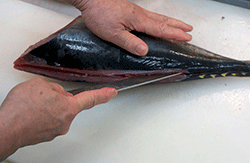 |
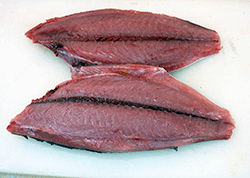 |
| 7,Make a notch at the dorsal fin on the lower body side and cut open to the position of the backbone. | 14,The state where the centralbone is separated and made into three pieces disassembling |
Next is the fillet work process.
| 2 types of albacore fillets | |
|---|---|
 |
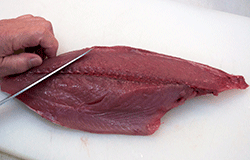 |
| 1,Cut the lower body from the caudal fin side in the left posture. | 1,Cut the upper body from the caudal fin side in the right posture. |
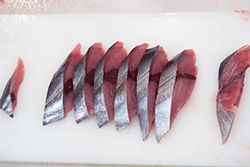 |
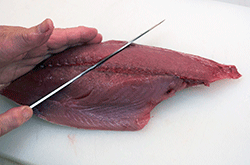 |
| 2,I made kiridashi on the caudal fin side and the head side, and made 6 slices of the same size as possible. | 2,Keep in mind the thick slices and proceed. |
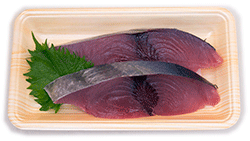 |
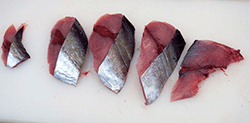 |
| 3,2 pieces of albacore fillet | 3,I made kiridashi on the caudal fin side, made 3 thick slices. |
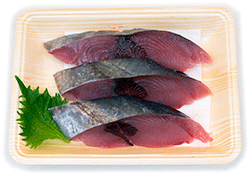 |
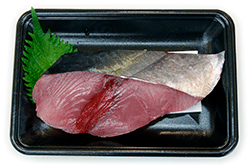 |
| 4,3 pieces of albacore fillet | 4,1 slice of thick fillet |
And finally, the voluminous serving product of albacore hiratsukuri sashimi.
| How to make the voluminous serving product of albacore hiratsukuri sashimi | ||
|---|---|---|
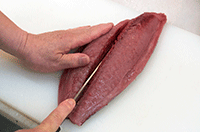 |
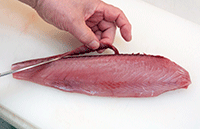 |
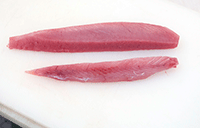 |
| 1,Cut next to the chiai bone of fish in the lower body with a yanagiba knife and stop leaving the thickness of one skin. | 7,Scrape off the blood vessels that still remain in the fish meat. | 13、The back body was sakudori processed. |
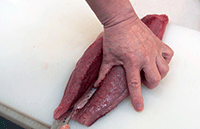 |
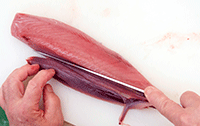 |
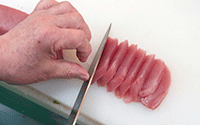 |
| 2,Imagine an L-shape, turn the yanagiba knife from vertical to left, and remove belly body . | 8,Move the yanagiba knife in a U shape and remove the chiai meat of fish from the back body. | 14,Make the rectangular part of the back body hiratsukuri sashimi |
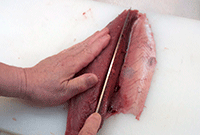 |
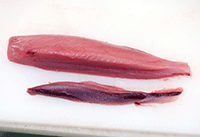 |
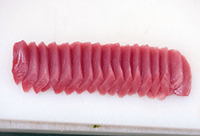 |
| 3,Next, the back body repeats the same work. | 9,The state where chiai meat of fish is removed from the back body | 15,Only the rectangular part of the back body is 17 pieces |
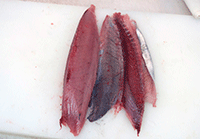 |
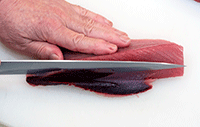 |
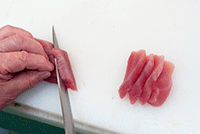 |
| 4,The state where the back body is separated from the skin. | 10、Remove the chiai meat of fish from the belly body. | 16,Make the triangular part hiratsukuri sashimi. |
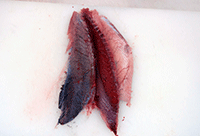 |
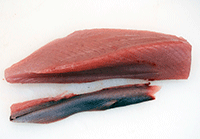 |
 |
| 5,The remaining chiai meat of fish and chiai bone of fish and skin. | 11、State that belly body of chiai meat of fish has been removed | 17,Only the triangular part of the back body is 13 pieces |
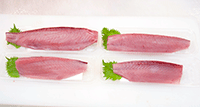 |
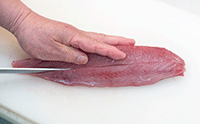 |
 |
| 6,A product for selling one fish as fushi | 12,Cut straight and parallel to make saku from the skin side of the back body. | 18,17 slices of the voluminous serving product of albacore hiratsukuri sashimi |
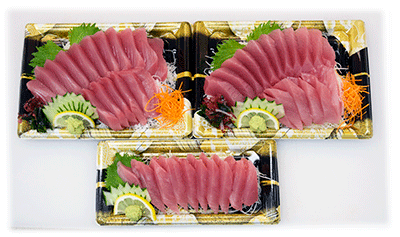 |
||
| By adding the belly body, this much hiratsukuri sashimi was completed with the half body of albacore. | ||
The deliciousness of fish is not limited to fatty
The above products were completed using fresh albacore, which weighs about 2 kg. Fresh albacore rate is not a big mistake to see that it same thing almost bonito, origin market is trading at about 500 yen / kg, from roughly 300 yen / kg. If the arrival of albacore is small, it may exceed 500 yen / kg, but basically it is unthinkable to exceed 1,000 yen / kg.
Assuming that the purchase price of the albacore handled this time is 500 yen / kg, one albacore weighing 2 kg can be calculated as 1,000 yen, so the half body is 500 yen. The fact that these 3 packs can be made for 500 yen means that the cost of 1 pack is quite low even if the material cost is calculated. The fillet is also a normal size with 6 slices and a thick slice with 3 slices, so if the half body is 500 yen, the cost is over 80 yen and a little less than 170 yen, respectively, which also has high cost performance.
Albacore is far from the world that makes a noise about millions and tens of millions of natural bluefin tuna. But if the albacore isn't worth eating, it's not at all. The main raw material for sea chicken (a registered trademark of Hagoromo Foods), which is a representative business card for tuna cans, is albacore, and unlike popular products called light meat using yellowfin tuna and bonito, albacore is positioned as a high-grade product called white meat.
Sea chicken is now an indispensable product as a part of eating habits, and it is very active in sushi, sandwiches, salads, rice balls, etc., and it can be said that it is a very popular star especially for children. In other words, as a cooking ingredient, "softness", which is one of the drawbacks when eating raw with sashimi, changes to the merit of "easy to loosen".
Furthermore, the aspect of "less fat", which is another drawback, can be linked to the merit of being able to cook in any way without bias as a basic taste. In addition, this point can be said to be valuable in the sense that you can enjoy the original taste of natural fish at a low price in the era when rugged and greasy farmed fish are in full bloom.
In order to sell albacore, it is better to stop selling albacore, which is an impossible toro in the world, by misleading it with your mouth, and sell albacore fish, which has a characteristic of low fat content, in a straightforward manner. Albacore can have a delicious taste that cannot be experienced with farmed bluefin tuna, and I think it is necessary to enjoy such a different taste when eating fish.
| Please access the following URL if you want to secure using SSL. All pages in the site will be secure pages. |
https://secure02.blue.shared-server.net/www.fish-food.co.jp/message english 4.2021.html |
An opinion and the communication are to iinfo@fish food times
Date of updating 1 Apr. 2021
